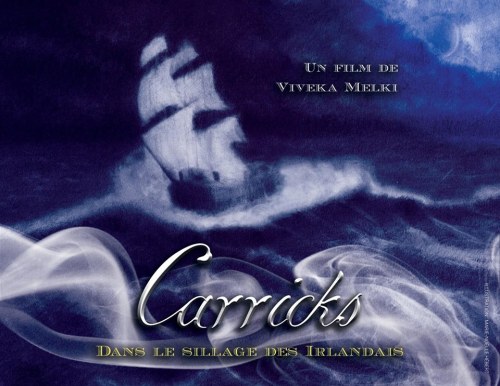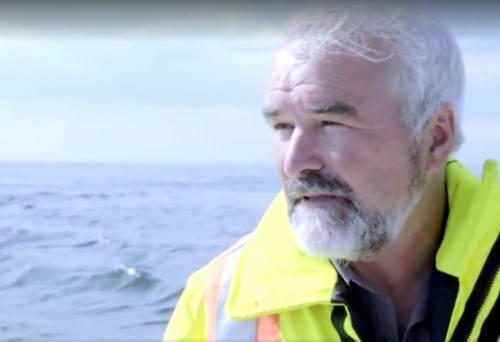Outstanding new documentary by Viveka Melki, Carricks, dans le sillage des Irlandais, featuring Charles Kavanagh, descendant of Famine Irish Survivors of the Wreck
by irishcanadianfamineresearcher

Carricks, dans le sillage des Irlandais (in French, with English subtitles)
Le 17 mai 1847, le navire irlandais Carricks fait naufrage à Cap-des-Rosiers, à quelques centaines de mètres au large des plages gaspésiennes, avec à son bord 187 passagers irlandais et un violon signé Stradivarius.
http://ici.radio-canada.ca/audio-video/media-7693449/carricks-dans-le-sillage-des-irlandais
La quête de Charles Kavanagh est aussi celle de bien d’autres descendants d’immigrants irlandais; à travers l’histoire du naufrage du bateau Carricks en 1847, il ne lève pas seulement le voile sur l’histoire de sa famille, mais aussi l’héritage des Irlandais au Québec.
On May 17, 1847, the Irish ship Carricks was wrecked at Cap-des-Rosiers, a few hundred meters off beach in Quebec’s Gaspé Peninsula, carrying 187 Irish passengers and a Stradivarius violin.
Charles Kavanagh’s quest is also that of many other descendants of Irish Famine immigrants to learn more about their origins. He seeks to trace the story of the sinking of the Carricks Famine ship from which his ancestors Patrick and Sarah Kaveney survived in May 1847, and unveils the history not only of his family, but also the legacy of the Irish in Quebec.
The film is directed by Viveka Melki and narrated by Charles Kavanagh, in collaboration with the archaeologist Martin Perron and the historians Simon Jolivet and Jo-Anick Proulx.




Margaret Grant MacWhirter, Treasure trove in Gaspé and the Baie des chaleurs (1919), p. 13.
Cap de Rosier has a tragic interest on account of the tales of marine disaster with which it is associated. The story is still told in Gaspe village of the good ship “Carricks” which sailed from Sligo, Ireland, in May, 1847.
And old lady, perhaps the sole survivor, remembered the occurrence when interviewed by the writer. She, a child of twelve years, was one of seven children, and like all the passengers, her family were emigrants. After a rough and uncomfortable passage of twenty-three days, the captain missed his reckoning in a blinding snow-storm, and in the darkness of the night, struck the cruel cape. One stroke of the angry wave swept her clean. Comparatively few were saved, after hours of cold, hunger and fear such as may be imagined. The inhabitants came to the rescue, and treated the pitiable survivors with kindness. Truly the beach presented a gruesome spectacle the following day, strewn for a mile and a half with dead bodies. For a whole day two ox-carts carried the dead to deep trenches near the scene of the disaster. In the autumn the heavy storms sweep within sound of the spot. Thus peacefully, with the requiem of the waves and winds they rest. In recent years a monument has been erected to their memory by the parishioners of St. Patrick’s Montreal. Alas! this is only one of the many sorrowful tales which are related of Cap de Rosier.

Petition for Reimbursement for Expenses in Caring for Carricks’ Survivors:


From Sligo Champion (April 22 2017)
Canadians walk in Famine ship ancestors’ footsteps
Canadian descendants of a family who fled Sligo during the Famine returned last weekend to retrace their last journey on Irish soil.
Rose Marie and Terry Stanley walked the Famine Trail from the Caves of Keash to Sligo Quay on Saturday to mark the 170th anniversary since their forefathers, Patrick and Sarah Kaveney and their six children left Cross on the 5th of April 1847.
They were joined by eight Canadian family members, their Ward cousins from Keash and the Keaveneys from Dublin. On their arrival at the Quay the group were honoured at a civic reception at City Hall hosted by Mayor of Sligo Municipal District Cllr Marie Casserly.
Rose Marie expressed her appreciation to the Mayor and spoke of the impact of the walk together with the unexpected gift of finding the family’s Sligo roots and connecting with cousins here in Ireland. She committed to returning in 2021 to walk the Famine Trail again.
While here Rose Marie will present a play called ‘EMIGRANT’ based of the epic journey of her ancestors, Patrick Kaveney and Sarah McDonagh. It will be presented in Cliffoney Hall on Thursday, 20th April at 8.30 pm, and in White Hall Keash on Saturday 22nd April again at 8.30pm. In Cliffoney Anne Hoey and Frank Kielty will assist the presentation.
Patrick and Sarah,their six children and 172 other emigrants from Lord Palmerston’s estates sailed on board the Carricks of Whitehaven to Quebec.
The ship ran into a late winter storm and was shipwrecked on 28th April 1847, in the Gulf of St Lawrence, just off the coast of Cap des Rosiers, Canada. Only 48 survived, including Patrick and Sarah together with their son Martin, but their five daughters perished.
From a family story I believe my Irish ancestors were on the voyage. There name was O’Rafferty. The parents and 8 children. They all survived the wreck and made it into Montreal. The mother died within 2 weeks of arrival and was buried in the mass grave of Mount Royal. I am not sure how they survived before they took a ship for Essex County, Ontario, Canada.